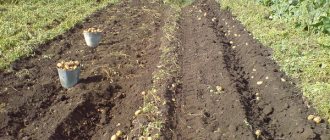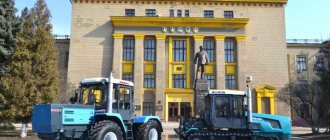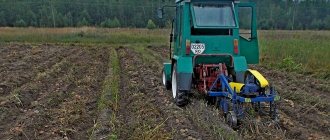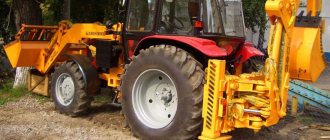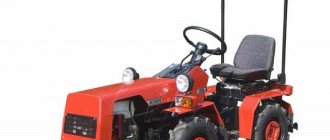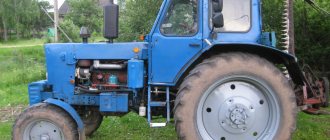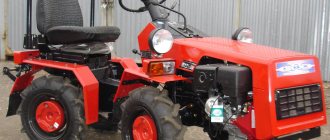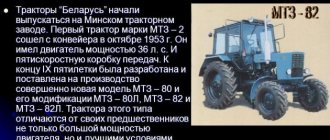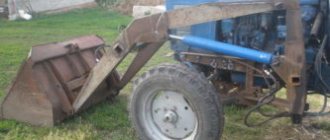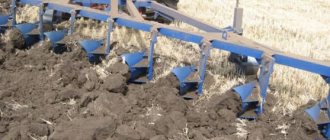KUHN on MTZ-80, 82: rear linkage
The main differences between the MTZ-80 and MTZ-82 attachments.
Main technical characteristics of KUNs for MTZ. One of the most common and simplest types of special attachments, of course, can be called KUN at MTZ, which has become a kind of popular name - a common name for any similar type of attachments for tractors. KUN is a universal mounted hay hauler, which is essentially a tractor front-end hydraulic loader for moving, lifting and lowering various large loads.
However, if KUN is initially a hay hauler, this does not mean that it cannot work with other loads and materials that are not even remotely included in the category of hay and silage, and are not related to agricultural work. The range of application of tractors with similar attachments is very wide and varied. For example, in the same excavation work, it is capable of moving large masses of soil from one place to another, covering any distance. Advantages of front mounted equipment and technical capabilities
Slightly different equipment is installed on different modifications of Belarusian tractors, with minor technical and operational changes. Here the ratio of the load capacity and the canopy sweep may vary, which in one way or another directly affects the operation of the equipment and its tasks during operation.
1. MTZ - 80 with KUN is equipped with a prototype of the PF - 1 attachment, which has the following technical characteristics:
- weight of lifted loads up to 1 ton;
- lifting height limit up to 3.5 meters;
- the weight of the loader itself is 900 kg;
- maximum speed of cargo movement is up to 20 km/h.
2. MTZ-82 with KUN is equipped with a more advanced PKU-0.8 device than its prototype, which is somewhat narrower than its predecessor and lacks some parts, which include the so-called “rocker” with a quick-change mechanism.
- weight of lifted loads up to 800 kilograms;
- high-rise ceiling up to 3.5 meters;
- weight of the mounted loader up to 700 kg;
- maximum travel speed with load up to 20 km/h.
Do-it-yourself kun at MTZ: dimensions, drawings, photos, videos
The main differences between the MTZ-80 and MTZ-82 attachments. Main technical characteristics of KUNs for MTZ.
One of the most common and simplest types of special attachments, of course, can be called KUN at MTZ, which has become a kind of popular name - a common name for any similar type of attachments for tractors. KUN is a universal mounted hay hauler, which is essentially a tractor front-end hydraulic loader for moving, lifting and lowering various large loads.
However, if KUN is initially a hay hauler, this does not mean that it cannot work with other loads and materials that are not even remotely included in the category of hay and silage, and are not related to agricultural work.
The range of application of tractors with similar attachments is very wide and varied. For example, in the same excavation work, it is capable of moving large masses of soil from one place to another, covering any distance.
Advantages of front mounted equipment and technical capabilities
Slightly different equipment is installed on different modifications of Belarusian tractors, with minor technical and operational changes. Here the ratio of the load capacity and the canopy sweep may vary, which in one way or another directly affects the operation of the equipment and its tasks during operation.
1. MTZ - 80 with KUN is equipped with a prototype of the PF - 1 attachment, which has the following technical characteristics:
- weight of lifted loads up to 1 ton;
- lifting height limit up to 3.5 meters;
- the weight of the loader itself is 900 kg;
- maximum speed of cargo movement is up to 20 km/h.
2. MTZ-82 with KUN is equipped with a more advanced PKU-0.8 device than its prototype, which is somewhat narrower than its predecessor and lacks some parts, which include the so-called “rocker” with a quick-change mechanism.
- weight of lifted loads up to 800 kilograms;
- high-rise ceiling up to 3.5 meters;
- weight of the mounted loader up to 700 kg;
- maximum travel speed with load up to 20 km/h.
If the PKU - 0.8 is attached directly to the tractor frame, naturally disrupting the uniformity of the load during operation and putting pressure on the frame with the entire loaded mass, which leads to premature breakdowns when working with heavy loads, then the PF - 1 is equipped with its own frame, attached under the tractor to the rear axle , which evenly distributes the entire load.
In addition, PF-1 uses slightly more powerful cylinders, while the boom and other parts with mechanisms are made from reinforced (thickened) metal. Consequently, despite all the external similarities, the KUN on MTZ of different models still has significant differences in operation.
Note
Many skilled mechanics make the KUNS they need with their own hands, producing quite working and acceptable attachments. This does not mean that it is necessary and possible to refuse to purchase a high-quality factory product, but it does not exclude this possibility.
However, any homemade KUHN, even one manufactured according to all the rules and regulations, is certainly technically inferior to its factory-made counterparts.
How to make a KUN for a tractor with your own hands
A homemade KUN at MTZ is a special attachment that is designed to expand the functionality of the tractor. Installing a homemade or purchased KUN on the rear linkage of an MTZ tractor improves the operation of the machine.
What is the purpose of KUN at MTZ?
Such equipment is driven by a hydraulic system, which makes it possible to perform the following types of work:
- Build houses outside the city.
- Repair the road surface.
- Carry out various earthmoving works.
- Carry out loading and unloading operations.
The homemade product installed on a mini tractor with KUN can be of two types:
- Equipment type PF-1, which has its own supporting frame. This homemade KUN is attached to a tractor, which protects the machine from overturning. Such equipment weighs about 900 kg, is driven by hydraulic cylinders, has a load capacity of 1 ton and a speed of 20 km/h.
- The PKU-08, which is a more modern modification of the PF-1, is also installed on the rear linkage of the MTZ 82. It is not difficult to attach a homemade KUN or a KUN assembled by your own to a tractor. But it is worth considering that PKU-08 differs from MTZ in carrying less load than the previous arm of the equipment. The PKU-08 weighs only 700 kg, reaches a speed of up to 20 km/h, and is capable of lifting 800 kg of cargo at a time.
The kuna model on MTZ 80 or MTZ 82 is produced at the Salskselmash plant, which specializes in agricultural machinery.
KUN 10 is a functional and practical boom, created specifically for the specified MTZ models. Kun can also be installed on a Chinese tractor.
Although the equipment works better with Minsk technology. Among the advantages of KUN 10 it is worth noting such characteristics as:
- Versatility. The Belarus tractor is capable of being a loader and performing earth-moving work like an excavator. The machine is also used as a bulldozer or leveler.
- Compactness. The installation of KUN 10 at MTZ allows the equipment to be used in the city and on small construction sites. Therefore, such a tractor is constantly used for landscaping territories, digging holes and trenches, laying communications, etc.
- High level of productivity.
- Reliability.
- Ease of use.
- Easy to use.
KUN for wheeled tractors has the following design:
- The boom, which is controlled by four hydraulic mechanisms, two of them are used to lift loads, and another two are used to adjust the angle of inclination of the bucket.
- The drive that powers the chassis. Its system also has the option of a connector, with the help of which it is connected to the tractor.
- The boom control panel is installed in the tractor cab.
- Buckets can have different volumes, which vary from 0.35 to 1.5 m³.
Characteristics of a homemade unit
Homemade KUN for a mini tractor: installation features.
The manufacturer offers buckets of various sizes, fork equipment (needed for agriculture and loading and unloading), rake grids for collecting hay, straw, and mown grass.
Grabs for logs are sold separately, so KUNs are used for logging. Additionally there are grippers for bales and rolls. You can also find jaw dumps in stores. The basic equipment for a homemade KUN for a mini tractor may vary.
The dimensions of KUN 10 can be different, depending on the modification of the equipment. The carrying capacity of the rake grid, dumps and grabs is 500 and 800 kg.
The equipment bucket rises to a height of 2.5 m, and the rake grid - to 3.5 m. The unloading angle of the bucket, on average, ranges from 55 to 65º.
The performance and size of the equipment depend on the chassis that needs to be mounted on a homemade mini tractor or other self-propelled unit.
Buying attachments is expensive, so you can make a KUN for MTZ with your own hands.
Assembling and installing such a tool is simple, you just need to draw up a diagram of the equipment and mark on it the place where it will be mounted on the wheeled tractor.
A homemade KUN is attached to the rear linkage of an MTZ 80 or 82. This is much easier than installing a KUN 10, which is available in a front modification.
A homemade tractor differs from a factory one and has several significant advantages:
- Ease of mounting.
- Selection of the length and height that is necessary for specific work on the ground or at a construction site.
- You can use scrap materials left over from other equipment.
In order to make a KUN for a homemade or factory tractor, you need to stock up on the following equipment:
- welding machine;
- tools for cutting and cutting metal;
- sledgehammer;
- hammer;
- wrenches.
If you have no welding experience, then you should find a specialist who knows how to work with the machine. This determines the quality and reliability of welding seams, on which the installation and duration of use of the KUN largely depends.
Difference in attachments
If the PKU - 0.8 is attached directly to the tractor frame, naturally disrupting the uniformity of the load during operation and putting pressure on the frame with the entire loaded mass, which leads to premature breakdowns when working with heavy loads, then the PF - 1 is equipped with its own frame, attached under the tractor to the rear axle , which evenly distributes the entire load.
In addition, PF-1 uses slightly more powerful cylinders, while the boom and other parts with mechanisms are made from reinforced (thickened) metal. Consequently, despite all the external similarities, the KUN on MTZ of different models still has significant differences in operation.
Note
Many skilled mechanics make the KUNS they need with their own hands, producing quite working and acceptable attachments. This does not mean that it is necessary and possible to refuse to purchase a high-quality factory product, but it does not exclude this possibility.
However, any homemade KUHN, even one manufactured according to all the rules and regulations, is certainly technically inferior to its factory-made counterparts.
Types of attachments for farming
In most cases, the following types of attachments are used to care for the local area:
- front loader for mini tractor – equipment that is also intended for loading trucks and trailers;
- excavator bucket - aka kun. This is an effective device that makes it possible to level the soil on a plot of land, clear snowdrifts and load garbage onto a trailer.
All of the above devices have a very similar design. To make them you do not need to buy expensive materials and special equipment. However, in order for the device to be reliable, you will need to follow the instructions in the drawings and act strictly in a certain order.
Mini tractor bucket - equipment advantages
A homemade kun for a mini tractor is one of the types of front-end loaders. It will certainly come in handy in situations where it is necessary to load bulk materials and products onto a trailer or transport short distances: crushed stone, sand or grain.
Advantages of buckets include:
- ease of maintenance;
- high reliability;
- ease of installation and removal;
- hydraulics on the minitractor make the buckets as easy to use as possible;
- the ability to lift large loads for a compact mini tractor.
Another important advantage of the bucket is its ease of self-assembly. Thanks to this, almost every owner of a mini tractor will be able to acquire this useful device.
KUHN for the rear linkage of a tractor: what equipment can be used
The homemade product installed on a mini tractor with KUN can be of two types:
- Equipment type PF-1, which has its own supporting frame. This homemade KUN is attached to a tractor, which protects the machine from overturning. Such equipment weighs about 900 kg, is driven by hydraulic cylinders, has a load capacity of 1 ton and a speed of 20 km/h.
- The PKU-08, which is a more modern modification of the PF-1, is also installed on the rear linkage of the MTZ 82. It is not difficult to attach a homemade KUN or a KUN assembled by your own to a tractor. But it is worth considering that PKU-08 differs from MTZ in carrying less load than the previous arm of the equipment. The PKU-08 weighs only 700 kg, reaches a speed of up to 20 km/h, and is capable of lifting 800 kg of cargo at a time.
The kuna model on MTZ 80 or MTZ 82 is produced at the Salskselmash plant, which specializes in agricultural machinery. KUN 10 is a functional and practical boom, created specifically for the specified MTZ models. Kun can also be installed on a Chinese tractor. Although the equipment works better with Minsk technology. Among the advantages of KUN 10 it is worth noting such characteristics as:
- Versatility. The Belarus tractor is capable of being a loader and performing earth-moving work like an excavator. The machine is also used as a bulldozer or leveler.
- Compactness. The installation of KUN 10 at MTZ allows the equipment to be used in the city and on small construction sites. Therefore, such a tractor is constantly used for landscaping territories, digging holes and trenches, laying communications, etc.
- High level of productivity.
- Reliability.
- Ease of use.
- Easy to use.
KUN for wheeled tractors has the following design:
- The boom, which is controlled by four hydraulic mechanisms, two of them are used to lift loads, and another two are used to adjust the angle of inclination of the bucket.
- The drive that powers the chassis. Its system also has the option of a connector, with the help of which it is connected to the tractor.
- The boom control panel is installed in the tractor cab.
- Buckets can have different volumes, which vary from 0.35 to 1.5 m³.
Kun, tractor bucket - types, DIY production, video
A tractor bucket is a type of loader for heavy equipment. According to the principle of operation, this is a standard front loader; a hydraulic system is responsible for its operation. KUHN turns equipment into an excavator, tractor loader, leveler or bulldozer.
The universal mounted bucket was originally made for the purpose of loading silage or hay. But the scope of application of this equipment has expanded significantly, which is why they are actively used in warehouses for transporting goods, in construction, for landscaping, and for snow removal.
Advantages of a tractor front loader:
- Convenient for maintenance, since all components are within reach and can be easily replaced;
- Quick installation and dismantling of various canopies;
- Reliable (this is not always the case with a homemade loader);
- High load capacity;
- The reinforced hydraulic system simplifies the operation of the unit.
Types of attachment adapters for tractors
The modern range of tractor auxiliary equipment is extremely diverse, which makes it possible to use it in several sectors of the national economy. Among them:
I. Agriculture:
- plows;
- tractor harrows;
- seeders;
- potato and garlic planters and diggers;
- multi-row seeders;
- fertilizer spreaders;
- mowers;
- sprayers;
- trailer;
- cultivators;
II. Construction:
- coon for a tractor;
- motor drill;
- trencher;
- rippers;
- winch;
- loader;
- cargo trailers;
III. Utilities:
- snow shovel;
- sprinkler;
- devices for washing concrete and asphalt;
- dispersers of sand and chemical reagents for melting ice;
- rotary snow blower;
- bulldozer bucket;
IV. Forestry industry:
- skidding attachment;
- loader.
You can buy them ready-made or make them yourself.
Methods for connecting attachments to a tractor
There are 3 mechanisms for aggregating the tractor with auxiliary attachments:
- hitch mechanism and hitch;
- towing devices;
- power take-off shaft (PTO).
The tractor hitch acts as a connector for lighter and smaller adapters. Modern tractors are produced with a three-point hitch. Although older models have a classic two-point hitch.
The hitch is used to aggregate the tractor with a trailed or towed device. Located in the area of the lower links of the hinged mechanism.
According to the method of connection, couplings are distinguished:
- universal;
- hydroficated;
- automatic.
Towing mechanisms are represented by hooks equipped with shock absorbers and locking blocks.
The PTO is a working unit that receives torque from the power plant and transmits it to the active attachment for tractors. Depending on the location, tractors come with rear and front PTO. Outdated units that were produced without a PTO can be improved with a homemade power take-off system.
Characteristics of a homemade unit
Homemade KUN for a mini tractor: installation features. The manufacturer offers buckets of various sizes, fork equipment (needed for agriculture and loading and unloading), rake grids for collecting hay, straw, and mown grass. Grabs for logs are sold separately, so KUNs are used for logging. Additionally there are grippers for bales and rolls. You can also find jaw dumps in stores. The basic equipment for a homemade KUN for a mini tractor may vary.
Coon and loader for a mini tractor: features of use, nuances of self-production
A variety of attachments significantly expands the capabilities of your mini tractor. One of the most useful and productive types of hitch is considered to be a hitch for a mini tractor. This is a versatile mounted excavator that can be used as a loader. A homemade loader for a mini tractor will become an indispensable assistant on your site, especially if you are undergoing construction work. This equipment is ideal for moving large masses of sand, crushed stone, and gravel. It is also very convenient to transport grain crops. In winter, the mini tractor bucket can be used to remove snow.
How to make a KUN for MTZ with your own hands
It is imperative to make drawings of a homemade KUN so that there are no problems with cutting the metal into individual elements. Let's look at how to make such equipment yourself:
- You will need profiles and sheet metal. The thickness of the materials must correspond to the load that is planned.
- You will need to purchase several hydraulic cylinders - 2 large ones to lift the bucket, and 2 smaller ones. They are needed to adjust the inclination level and equipment parameters.
- Cylindrical joints, without which it is impossible to assemble the entire structure of the wheel unit.
When you have all the necessary tools and materials, you can begin the process of assembling the KUN with your own hands.
You can find drawings and diagrams on the Internet, on specialized forums and websites, or you can create them yourself.
This will allow you to cut the metal so that there is a minimum amount of waste. You can contact design firms, where employees will help you create a good drawing of the future attachments for the tractor.
The loader must consist of two rectangular frames. One of them - the external one - should be larger. It is this that is aggregated, i.e. Attaches to the rear tractor of the tractor. The inner rectangular frame is cut from sheet iron. Large hydraulic cylinders must be welded to the bottom of the frame, and a spacer must be installed on top. It is needed to create a stiffening rib.
The majority of the structure is the boom attachment, accounting for more than 70%. To install it, you will need the help of another person who should know how to install it correctly. The product is placed closer to the frame and connected to the cylinder. Then you need to attach the middle part to it, after which the bucket is hung. It is worth taking into account such an important nuance as the relationship between the length of the boom and the stability of the tractor. If the boom radius is more than 2 m, then a counterweight must be installed on the front frame. This will allow the MTZ to stand firmly on the ground and not tilt in different directions while carrying loads.
The installed bucket is made independently, also from sheet metal. The elements must be welded so that a structure similar to a boomerang is obtained. It should have 3 attachment points - in the center and along the edges.
Do-it-yourself mini tractor from a Neva walk-behind tractor. Making a mini tractor from a Neva walk-behind tractor
By creating a mini tractor from a Neva walk-behind tractor with your own efforts, you will receive the following amenities:
- This technique does not require a large space for its placement. This means there is no need to build a garage for it.
- The price is significantly lower than the price of a ready-made working adapter for a walk-behind tractor.
- Operation requires the cheapest fuel and in small volumes. 2 liters will be enough.
- Maximum speed – 30 km/h.
- It is not difficult to get spare parts for it. They are available almost everywhere and their prices are quite low.
- If you equip such a vehicle with tires with deep tread, you can achieve high cross-country ability and excellent traction.
- Thanks to its compact size, you can also work in difficult areas where trees grow abundantly. It also allows for comfortable work in the local area. In this case, neither asphalt nor paving slabs are affected.
Of course, creating such a masterpiece yourself is possible if you have certain skills and knowledge. Before the main work, you will need to analyze many different drawings and diagrams, read technical literature and watch useful videos.
There is no universal scheme or similar sets of drawings. Since devices from different manufacturers have differences in design, power and other parameters. How to make a mini tractor from a Neva walk-behind tractor? Start by choosing a model and drawings.
Minitractor from a Neva walk-behind tractor. Dimensions
If you are unable to purchase or find the Neva walk-behind tractor, its analogues, for example, Zubr, Salyut and Argo, will do just fine. There are also a number of Chinese analogues. But Russian products are in great demand. Drawings and diagrams of a homemade tractor from a Neva walk-behind tractor:
DIY mini tractor diagram
You will also find it useful in your work:
- metal corners and pipes;
- stainless steel (1 sheet);
- drill;
- welding equipment;
- attachments;
- standard set of installation tools (screwdrivers, wrenches, nuts, bolts, etc.).
A mini tractor can be equipped with only the most necessary arsenal:
- two suitable wheels;
- comfortable chair;
- driving;
- levers.
How to make kun on T-25 at home
Before determining the dimensions of the kun on the T-25 and starting to manufacture it yourself, you need to familiarize yourself with its main advantages. First of all, this is a significant cost savings compared to purchasing a factory-made kuna, which allows farmers to reduce their costs.
In addition, other advantages of a homemade tool should be mentioned:
- versatility. A kun made independently can be used with various models of tractor equipment;
- ubiquitous equipment and tools are used to manufacture the device;
- simple design, easy to maintain and repair.
However, it should be remembered that making kuna yourself has a number of disadvantages, the main one of which seems to be the probable lack of necessary materials from the farmer. This will lead to the fact that due to the purchase of missing blanks and parts, the cost of the product may increase slightly.
Most often, you need to make a rear-mounted coon, which will require the following elements:
- metal profiles, steel sheets;
- hinged-cylindrical elements, which should be selected in accordance with the dimensions of the unit;
- 3 hydraulic cylinders.
You will also need various hand tools, welding equipment, a circular saw or a gas cutting machine. In order to avoid mistakes, it is advisable to adhere to the following procedure:
- Assemble a rectangular kun base using metal pipes. Its rear part is fixed to the attachment, slightly exceeding its boundaries.
- In the middle of the base it is necessary to place another rectangular element made of pipes into which the hydraulic cylinder is mounted.
- In the upper part of such a rectangle there is a spacer and 4 hinges for securing the boom.
- Make an arrow using a metal profile. On top of the assembly you will need to place fasteners for the hydraulic cylinder and base.
- Mount the hinges in the middle part of the tractor.
- Assemble the bucket using a large sheet of steel, as well as 4 smaller pieces. The parts of the bucket are connected to each other by welding.
After successful manufacturing, you need to install the kun on the general structure, which will allow it to be used in the future. In order to avoid mistakes, you can read the special video instructions.
Drawings with dimensions
In order to independently produce a high-quality, reliable and durable structure, the craftsman will need to use the Kuna drawing for T 25. This will ensure that the finished product meets the required dimensions and parameters, which will make it possible to use it together with a tractor.
The kun can be placed in the rear of the unit or the front at the master’s choice. But it must be taken into account that the length of the boom on which it is supposed to be placed should not exceed 2 meters. Otherwise, when operating and loading the bucket, the tractor may overturn.
To successfully make a bucket, the craftsman will need the following components:
- several steel sheets, whose dimensions must correspond to the dimensional parameters of the tractor for which the kun is being made;
- 2 large and 2 small hydraulic cylinders;
- connecting elements - bolts, nuts and others;
- necessary tools.
Homemade ladle
You can make a KUN for a mini tractor with your own hands, while saving money on the purchase of this device. You need to acquire a metal sheet (with a thickness of six millimeters), metal scissors, welding, iron pipes of various diameters.
The KUN for the tractor is made according to a simple scheme:
- The fasteners are welded to the box and motor. The structure is reinforced from below with a metal corner;
- The KUHN itself is manufactured. It is enough to cut a sheet of metal into rectangles, which are then welded into one structure. Welding must be of high quality so that the finished structure lasts longer. Pipes and rods with a diameter of 10 and 5 centimeters, respectively, are suitable for the racks;
- Installation of hydraulic booster. For its mobility, a sleeve with a diameter of about 3 centimeters is suitable;
- The support pipe is welded to the front of the unit, then the racks are combined and reinforced with “kerchiefs”;
- For normal rotation of the bucket, a cylinder installed on the right is used.
To make your own bucket, you need to know how to use welding and understand mechanics. If in doubt, it is better to purchase ready-made equipment that can be attached to the Kioti tractor and other popular models of equipment.
Video of making homemade kun
When planning to make a bucket for a tractor with your own hands, it is advisable to follow simple instructions that will allow you to achieve the desired result without serious difficulties. In order to eliminate the possibility of error, it may be useful to use a special video that details the entire procedure for manufacturing such an element.
The main stages in the manufacture of a front-mounted coon:
- Install supports under the hinged mechanism of the equipment, and then make special recesses in them intended for installing rods.
- Make an arrow using 2 profile contours, which are placed at an angle of 30 degrees. The circuits are connected to each other using jumpers located in the main parts of the structure.
- Using a welding machine, you will need to weld vertically located supports so that they protrude at the top of the future kun. They will also need to weld spacers attached to the corner of the boom.
- Using steel sheets, you will need to make eyelets - the boom will be attached to the bottom, and hydraulic cylinders prepared in advance will be mounted on the top.
- The other end of the cylinders is attached to a corner located right in the middle of the tractor boom.
- Install the finished bucket onto the attachments of the tractor being used.
This kind of design provides that large cylinders are responsible for the bending movements of this instrument, and small cylinders are responsible for the turning movements. This design option is perfect for use with attachments located on the front side of the structure.
For such a mechanism, it is especially important that its mass corresponds to the parameters of the tractor and does not contribute to its overturning.
Instructions for making KUN
Before work, you should carefully read the instructions on how to make a KUN on a mini tractor with your own hands, and watch the videos. Then you need to prepare the drawings. You can download them ready-made, or you can do them yourself, adjusting them strictly to the size and modification of the tractor.
The pattern of the parts is transferred to cardboard (corrugated cardboard from old boxes is suitable) in full size and cut out. Steel parts are marked and cut out using them. It is most convenient to mark with a marker - it does not erase, and after painting the marks will not be visible.
Necessary materials
For production you will need:
- For arrows: channel 10, sheet steel 4 mm.
- For racks: channel 18, sheet steel 10 mm.
- Fingers with blanks under them.
- Hydraulic cylinders grade 80-40-400 and 80-40-630.
- Loading lugs.
- Primer and paint for metal.
- Cardboard for cutting out templates.
- Tools you will need:
- Welding machine.
- Bulgarian.
- Metal scissors.
- Marker for marking.
The KUN for the rear linkage of the T 40 tractor is made of channel and steel. Factory structures are welded from the same material. The channel is used to manufacture the basic structure, onto which the actual working equipment is then hung: boom, loader forks, bucket.
Working equipment can also be made independently from channel and sheet steel, but, of course, it is better to do without it - perhaps you can find a bucket from an old excavator in the garage or you can buy a used boom. The fact is that without a sheet bending machine it is quite difficult to bend sheet steel exactly to size, and manufacturing using a vice and scissors will take so much time that the question of the payback of such a “homemade product” may arise. Hydraulic cylinders and lugs can be removed from an old truck or purchased at a wrecking yard.
As a rule, any craftsman has a certain supply of channel bars, but even if you need to buy all the materials at the base, it will be almost half the price than buying ready-made equipment. You can also consider purchasing metal from your own hands. If it was stored correctly, it will not be inferior in quality to a new one, and will cost significantly less.
Procedure
Manufacturing steps:
- Weld the right and left half frames.
- Secure the working equipment to the front (right) half-frame.
- Weld the left half-frame to the left side member, and the right half-frame to the right.
- Connect the half-frames with crossbars. The result is a supporting frame.
- Install hydraulic cylinders on the frame and connect them to the tractor hydraulic system.
- Before installation, the structure must be primed and painted to protect it from corrosion.
- A properly manufactured KUN is capable of lifting up to 800 kg with a loader and up to 600 kg with a bucket or mounting hook.
Pros and cons of making a homemade kun for a tractor
A tractor kun is a useful equipment for farming that allows you to level the top layer of soil, break up rubbish heaps and load trucks. Of course, such multifunctional special equipment is quite expensive. In this regard, many enthusiastic farmers decide to assemble a loader themselves, especially since making a kun for a tractor is not as difficult as it seems.
The most important advantage of a homemade kun is its low cost. Naturally, you will have to spend a little money during assembly, but at the final price, homemade tractor loaders will still be significantly inferior to their factory-made counterparts.
The second important advantage of the kun is that such an excavator can be used to work not only with domestic MTZ or Agromash tractors, but also with Kioti, Subaru tractors, as well as equipment from other imported brands.
The third advantage of a homemade kun is the simplicity of its design - this greatly simplifies its repair and maintenance.
The main disadvantages of creating a homemade loader include:
- a shortage of certain materials and equipment on the farm will lead to its purchase, which significantly increases the cost of a homemade kuna;
- Before assembly, you will need to practice a little in working with a grinder, a welding machine and a drill - this will allow you to more confidently hold the equipment in your hands directly when making a kun, as well as achieve better quality and balance when operating a tractor with a bucket.
In addition to the listed disadvantages, one more drawback should be highlighted in the form of a large amount of time spent on production. However, a properly made tractor bucket will quickly pay for itself due to its versatility and reliability.
Appointment of KUN
KUN is an abbreviation that stands for “universal mounted hay hauler”. Structurally, it is a basic “hitch” with a set of buckets of different sizes and (or) a forklift. This is multifunctional equipment capable of performing a wide range of work:
- transport bulk materials (sand, snow, manure, crushed stone, hay);
- load materials into trailers, mixing tanks, etc.;
- stack hay and straw into piles;
- remove snow;
- transport pallet cargo in warehouses;
- take out the garbage.
This is an ideal solution for a medium-sized farm, where you need to cultivate the field, clear roads, and load and unload building materials. One KUN will replace a whole set of specialized equipment. Perhaps special equipment is somewhat more convenient to use and more accurate to control, but if cheapness and simplicity are a priority, then KUN will be the optimal choice.
Depending on the type of work, you can produce a full set of replacement equipment, or you can limit yourself to just a bucket or boom.
Homemade loader for the rear linkage of an agricultural machine
This homemade bucket is considered the simplest option for use on T-25, T-40 tractors and other units whose design includes a rear linkage mechanism. This kun differs from a front loader in its ease of manufacture and installation on a tractor.
At the first stage of production, you will need to carefully study the drawings. They must indicate the size of each part used, as well as the method and sequence of its fixation in the overall structure.
After studying the diagrams, you will need to prepare the materials necessary for the work.
These include:
- metal profile and steel sheets - these will be used when assembling the base of the loader. The thickness of the metal used should be selected taking into account the size of the kun;
- swivel cylindrical joints – also selected based on the dimensions of the loader;
- 3 cylinders taken from the hydraulic system of any equipment unnecessary on the farm. Two of them must adjust the angle of the bucket. The third and largest cylinder is responsible for raising and lowering the boom.
From those used during work you will need:
- large hammer, mounting bolts, washers;
- screwdrivers, wrenches, pliers;
- powerful welding machine;
- gas cutter or grinder, capable of providing a perfectly even cut of metal parts.
The tractor loader is manufactured in the following order:
- First you need to assemble a base that is reliable and resistant to heavy weight. It should be taken into account that the frame will hold not only the bucket, but also the load it carries. The base of the kun should look like a rectangle assembled from square pipes. The lower part of the frame must be fixed to the tractor's hinged mechanism in such a way that it protrudes slightly beyond its edges. In the middle part of the frame you will need to install another rectangle welded from pipes. Next, you will need to install the largest cylinder on the inner rectangle. In its upper part you will need to first make 4 hinged joints to fix the boom, and a spacer;
- Next, the homemade loader must be equipped with a boom. It is assembled from a metal profile, the parts of which must be attached to each other at an angle of 30⁰. The hydraulic cylinder mount and the ends of the previously created base will need to be welded into the upper part of the boom;
- In the middle part of the boom you will need to install a hinge mechanism with a cylindrical shape. 2 movable joints are mounted into the mechanism, fixing 2 smaller cylinders together, as well as a crossbar used to install the bucket;
- The last step is to assemble the tractor bucket. To make it, you need to use one large steel sheet and 4 smaller parts. You will need to cut out rectangles from them, which, in the future, need to be welded to each other. In this case, the front sheet must be welded to the overall structure of the bucket at a certain angle. The video will tell you more about the manufacture of the loader.
Manufacturing a front loader for a tractor
The front loader differs from the previous bucket in that it is mounted on a mounted mechanism located in the front of the tractor. In the future, such an excavator can be actively used for snow removal, leveling the site and clearing debris.
As in the first case, before manufacturing the loader you will need to study the drawings. They must be as accurate as possible so that the finished loader is extremely balanced and reliable.
Next, you need to collect all the materials and tools necessary for the work.
The work must be performed using the following raw materials and equipment:
- several sheets of steel - their sizes are selected depending on the dimensions of the loader;
- 2 large and 2 small hydraulic cylinders;
- bolts, nuts and hinge joints;
- grinders and drills;
- welding machine;
- pliers, screwdrivers, wrenches.
The sequence of manufacturing a front loader for a tractor should look like this:
- First of all, metal platforms must be installed under the front linkage mechanism of the tractor to serve as a support for the loader. In the installed platforms, you will need to make recesses for mounting rods;
- The next step is to assemble the arrow. To manufacture it, you will need to make 2 contours from profiles, which must be connected to each other at an angle of 30 degrees. Both circuits must be attached to each other by means of jumpers located in the lower, central and front parts of the structure;
- One vertical support must be welded to each circuit so that each of them protrudes in its upper part. One additional spacer must be welded to each support, the second side of which must be attached to the corner located in the central part of the existing boom;
- Eyelets need to be made in the back of the bucket welded from steel sheets. You will need to attach a boom to the bottom eye, and 2 small hydraulic cylinders to the top eye. The second ends of the hydraulic cylinders must be attached to the angle located in the central part of the boom. Large cylinders must be carried from the central part of the boom to a support installed in a vertical position;
- At the final stage, you will need to install the finished structure on the front linkage of the tractor.
In a self-assembled front loader, front hydraulic cylinders are responsible for its rotation, and large rear cylinders are responsible for bending and extending the boom.
Having studied the procedure for making the front and rear buckets, almost every farmer will be able to make a tractor with two buckets - such a unit will have the highest possible performance and will help in performing various agricultural and household tasks.
Mini tractor with your own hands from a walk-behind tractor. Do-it-yourself mini tractor from a walk-behind tractor
For cultivating small plots of land, there is no better solution than a mini tractor made from a walk-behind tractor, made by yourself. Not every site owner can purchase a factory-made model, so they have to look for other solutions. It’s easier, for example, to buy a regular walk-behind tractor and remake it yourself.
Required tools and materials
The first stage of work consists of drawing up the drawing and preparing the equipment. If you have the appropriate skills, you can develop a diagram of components and mechanisms yourself or use those presented below.
As for components, ready-made factory kits for conversion are suitable - in any case, they are cheaper than the mini tractor itself. But this option is only suitable for those who do not want to save on absolutely everything.
Creating a homemade tractor will become impossible without:
- Grinders and discs.
- Fasteners and hardware (bolts and nuts).
- Channels and pipes with a metal base.
- Drills that come with drill bit sets.
- Welding equipment.
- Set with tools.
You can’t do without two suitable wheels along with a hitch and a driver’s seat, a steering mechanism, pedals, and the walk-behind tractor itself. It must have a sufficient level of power.
A heavy class walk-behind tractor with diesel fuel is an ideal option for a homemade mini tractor.
Examples of mini tractor drawings
Overall dimensions of the mini tractor
Layout drawing of the Ant mini-tractor
Kinematic diagram of a mini tractor
Choosing a walk-behind tractor
Among the important parameters for these devices it is worth highlighting:
- Cost and manufacturer.
- Plow size (if the mini tractor will be used to plow the land).
- Type of engine used.
- Weight.
- Power level.
Power. One of the most important parameters, since the performance and strength of a mini tractor directly depends on engine power. The more aggressive and heavier the load on the vehicle, the more powerful the walk-behind tractor needs to be.
Weight. If a homemade mini tractor will be used to plow the land, then the weight of the walk-behind tractor will be a critical parameter. The determining point is the type of land being cultivated: for hard soil varieties, you should not choose too light walk-behind tractors, otherwise the mini tractor will not cope with its purpose.
Although gasoline walk-behind tractors are much quieter, diesel wins in terms of the efficiency of its use: it has stable speeds and increased traction. A diesel engine will cope better with heavy soils and large areas.
In any case, for any purpose, the heavier the walk-behind tractor, the better the performance data of the future mini tractor.
Price and manufacturer. If possible, it is better to choose products from companies that have been on the market for a long time. If financial possibilities are limited, you can get by with cheaper analogues. Russian products will also be the best option for the majority.
Chinese walk-behind tractors
These are mostly copies of Russian models. Their cost is lower due to reduced production resources and savings on materials. This has a somewhat negative impact on the final quality of the product.
At the same time, the functionality does not differ from Russian walk-behind tractors. Recently, products of acceptable quality have appeared, although they are still far from comparable to their analogues from Russia. Popular Chinese walk-behind tractors include the Bison, Farmer, Centaur, Forte, Aurora, Zirka and others.
Russian products
The optimal solution with an affordable price. Motoblocks with a belt drive or with a transmission with the ability to transmit torque to, or. In any case, the process cannot be completed without the participation of a special belt.
A special feature of our developments is the simple design of the clutch system. The only maintenance procedure left is belt replacement. Soviet engineers also designed a gearbox that is recognized as one of the most successful on the market. Professional engines from foreign manufacturers are used. The units are functional and reliable.
How to make a KUN for a T-40 tractor with your own hands
Many farmers are interested in whether it is possible to make their own KUN on the T-40. Tractor T-40 from the mid-1990s. is not produced, but the model continues to be popular among farmers and summer residents. They are installed on the KUHN tractor, which is made by hand. The drawing can be found on websites on the Internet. It is posted by craftsmen who want to share their homemade products with other T-40 owners.
Is it possible to make a KUN on a T-40 tractor?
This model of equipment was produced at the Lipetsk plant to perform the following types of work:
- construction;
- agricultural, including for the processing of row crops;
- road;
- cleaning;
- arable, including greenhouses;
- in gardens and summer cottages.
The machine has excellent maneuverability, maneuverability, small size and weight. A well-assembled rear part allows you to install a homemade KUN on the T-40 or purchase a KUN on the T-40 tractor in a specialized store. Factory attachments that were used on the equipment were of several types:
- bulldozer blade;
- plow;
- stacker;
- trailer equipment;
- mower.
This or that type of KUN expands the capabilities of the equipment, which allows it to serve as a front loader.
